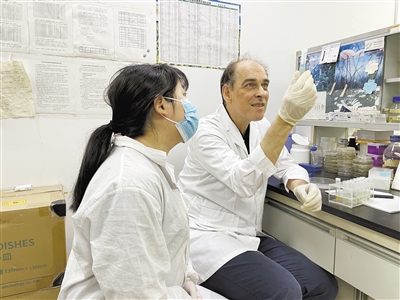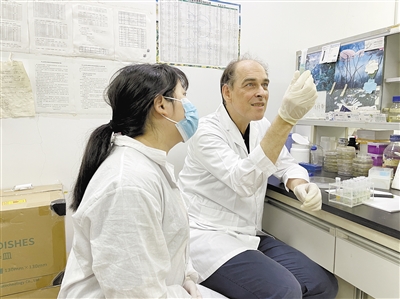
 Scientific Discovery Needs Coordination not Isolation
Scientific Discovery Needs Coordination not Isolation Creating Green Miracle in Wasted Site
Creating Green Miracle in Wasted Site 30%: China Contributes to Global Economy Growth
30%: China Contributes to Global Economy Growth 无标题
无标题 China Forges Closer Sci-tech Ties with ASEAN
China Forges Closer Sci-tech Ties with ASEAN Advances in Management of Natural Resources
Advances in Management of Natural Resources China-Eurasia Expo Encourages Cooperation
China-Eurasia Expo Encourages Cooperation WEEKLY REVIEW
WEEKLY REVIEW Multi-Faceted Industrialization of ICVs Speeds Up
Multi-Faceted Industrialization of ICVs Speeds Up 无标题
无标题
 |
| Professor Christian Staehelin (right) and his student in the lab. (COURTESY PHOTO) |
 |
No grass grew in an abandoned mining site in Ganzhou, Jiangxi province, in 2016, but six years later, the area is covered with towering trees and bamboo plantations. This miracle was made possible by Swiss scientist Christian Staehelin and his team working on plant growth-promoting microbes.
In 2005, Staehelin became the first full-time foreign professor at Sun Yat-sen University, Guangzhou. But he had formed a connection with China long before that when he met his future wife and career partner, Xie Zhiping, a Guangzhou native who studied at the University of Basel, Switzerland.
Valuable Assets
Staehelin's research over the past three decades was primarily devoted to rhizobia. These plant growth-promoting bacteria can be found in root nodules of legume plants. The rhizobia use nitrogen gas from the air as a nitrogen source, a process called biological nitrogen fixation (BNF). Nitrogen is an essential nutrient for plant growth, development and reproduction. "Compared with chemically synthesized fertilizers, BNF is much more environmentally friendly," he told Science and Technology Daily.
The rhizobia supply the plants with nitrogen, and the plants feed the bacteria with energy-rich compounds obtained through photosynthesis. This makes rhizobia capable of interacting and coexisting with their "destined" host plants. Once their "symbiotic communication code" is cracked, scientists can tailor rhizobia to the needs of different host plants to channel nitrogen from the air into plants.
Currently, Staehelin's team is conducting field studies with legumes. "Many legumes are excellent pioneer plants and most of them can form root nodules with rhizobia," said Staehelin.
Successful Exploration
Staehelin's team carried out soil remediation experiments in an abandoned mining area of Ganzhou, in the hopes of transforming barren land into lush forests. The secret weapon, said Staehelin is the use of legumes inoculated with rhizobia and other plant growth-promoting microbes.
However, the field research was not always plain sailing at the outset. The different environments between the lab and the mining site, as well as the harsh circumstances of nature, were challenges that confronted Staehelin's team. He said, "We visited the site almost ten times to do research, and we also brought back local soil for supplemental studies under greenhouse conditions."
Today, the previously barren mountains in this region are lush with vegetation. Simultaneously, plant succession is complete, and soil regeneration is progressing smoothly at the former mining site.
Locals even claimed to have discovered the footprints of a leopard, suggesting that the restoration of vegetation has attracted the return of very rare animals. The project is nearly complete, and has received a great deal of praise from professionals in this sector.
Staehelin's journey of scientific exploration has never wavered. The team is now going to apply the successful lessons to the Dabaoshan mining site in Shaoguan, Guangdong province.
As an expert highlighting sustainable development, Staehelin hopes to make more contributions to BNF, biodiversity and environmental protection work in China. He applauded China for its efforts in developing environmentally friendly products, exemplified by solar panels and wind turbines that are exported worldwide.
A Dedicated Scholar
Staehelin has spent over three decades conducting fundamental research to broaden people's scientific understanding. "The more efforts are put to research, the higher is the probability that a breakthrough would be realized," he noted. As a messenger promoting exchanges, he emphasized the importance of international collaboration for innovative academic research.
He believes that scientific research's ultimate goal is to serve society in an intact natural environment. "The results of sci-tech findings should be accessed by a wider audience, instead of shelving [it] in the library," he added.
"Challenges exist in the commercialization of scientific and technological achievements," said Staehelin. From his perspective, it takes time to transform fundamental research results into a concrete invention.
However, when asked about the factors regarding his success, the humble scientist attributes his accomplishments to "financial support, the good research facilities at Sun Yat-sen University and the hard work of his highly motivated team."
Apart from his academic research, Staehelin shoulders the responsibility of nurturing young researchers. The Swiss scholar is more than willing to share his experience with young scientists. He underlined the essential factors to achieve success, saying he hopes his students can always be curious, patient, persistent and optimistic throughout their scientific endeavors.

 Next
Next



